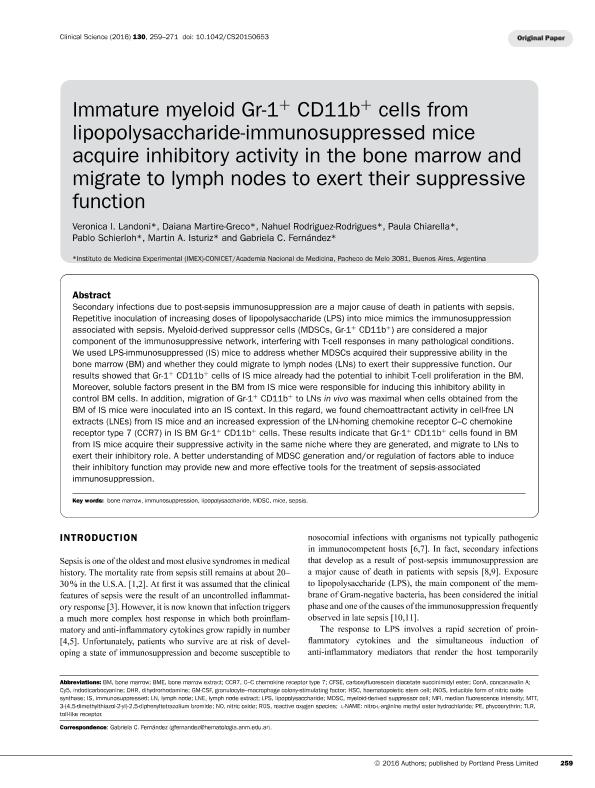Mostrar el registro sencillo del ítem
dc.contributor.author
Landoni, Verónica Inés

dc.contributor.author
Martire Greco, Daiana

dc.contributor.author
Rodriguez Rodrigues, Nahuel Emiliano

dc.contributor.author
Chiarella, Paula

dc.contributor.author
Schierloh, Luis Pablo

dc.contributor.author
Isturiz, Martín Amadeo

dc.contributor.author
Fernández, Gabriela Cristina

dc.date.available
2018-05-16T02:24:08Z
dc.date.issued
2016-01-14
dc.identifier.citation
Landoni, Verónica Inés; Martire Greco, Daiana; Rodriguez Rodrigues, Nahuel Emiliano; Chiarella, Paula; Schierloh, Luis Pablo; et al.; Immature myeloid Gr-1+ CD11b+ cells from lipopolysaccharide-immunosuppressed mice acquire inhibitory activity in the bone marrow and migrate to lymph nodes to exert their suppressive function; Portland Press; Clinical Science; 130; 4; 14-1-2016; 259-271
dc.identifier.issn
0143-5221
dc.identifier.uri
http://hdl.handle.net/11336/45318
dc.description.abstract
Secondary infections due to post-sepsis immunosuppression are a major cause of death in patients with sepsis.Repetitive inoculation of increasing doses of lipopolysaccharide (LPS) into mice mimics the immunosuppressionassociated with sepsis. Myeloid-derived suppressor cells (MDSCs, Gr-1+ CD11b+) are considered a majorcomponent of the immunosuppressive network, interfering with T-cell responses in many pathological conditions.We used LPS-immunosuppressed (IS) mice to address whether MDSCs acquired their suppressive ability in thebone marrow (BM) and whether they could migrate to lymph nodes (LNs) to exert their suppressive function. Ourresults showed that Gr-1+ CD11b+ cells of IS mice already had the potential to inhibit T-cell proliferation in the BM.Moreover, soluble factors present in the BM from IS mice were responsible for inducing this inhibitory ability incontrol BM cells. In addition, migration of Gr-1+ CD11b+ to LNs in vivo was maximal when cells obtained from theBM of IS mice were inoculated into an IS context. In this regard, we found chemoattractant activity in cell-free LNextracts (LNEs) from IS mice and an increased expression of the LN-homing chemokine receptor C?C chemokinereceptor type 7 (CCR7) in IS BM Gr-1+ CD11b+ cells. These results indicate that Gr-1+ CD11b+ cells found in BMfrom IS mice acquire their suppressive activity in the same niche where they are generated, and migrate to LNs toexert their inhibitory role. A better understanding of MDSC generation and/or regulation of factors able to inducetheir inhibitory function may provide new and more effective tools for the treatment of sepsis-associatedimmunosuppression.
dc.format
application/pdf
dc.language.iso
eng
dc.publisher
Portland Press

dc.rights
info:eu-repo/semantics/openAccess
dc.rights.uri
https://creativecommons.org/licenses/by-nc-sa/2.5/ar/
dc.subject
Antigens
dc.subject
Bone Marrow
dc.subject
Cd11b
dc.subject
Lymph Nodes
dc.subject
Sepsis
dc.subject
T Lymphocytes
dc.subject.classification
Otras Ciencias Biológicas

dc.subject.classification
Ciencias Biológicas

dc.subject.classification
CIENCIAS NATURALES Y EXACTAS

dc.subject.classification
Inmunología

dc.subject.classification
Medicina Básica

dc.subject.classification
CIENCIAS MÉDICAS Y DE LA SALUD

dc.subject.classification
Bioquímica y Biología Molecular

dc.subject.classification
Medicina Básica

dc.subject.classification
CIENCIAS MÉDICAS Y DE LA SALUD

dc.title
Immature myeloid Gr-1+ CD11b+ cells from lipopolysaccharide-immunosuppressed mice acquire inhibitory activity in the bone marrow and migrate to lymph nodes to exert their suppressive function
dc.type
info:eu-repo/semantics/article
dc.type
info:ar-repo/semantics/artículo
dc.type
info:eu-repo/semantics/publishedVersion
dc.date.updated
2018-05-03T14:12:21Z
dc.identifier.eissn
1470-8736
dc.journal.volume
130
dc.journal.number
4
dc.journal.pagination
259-271
dc.journal.pais
Reino Unido

dc.journal.ciudad
Londres
dc.description.fil
Fil: Landoni, Verónica Inés. Consejo Nacional de Investigaciones Científicas y Técnicas. Instituto de Medicina Experimental. Academia Nacional de Medicina de Buenos Aires. Instituto de Medicina Experimental; Argentina
dc.description.fil
Fil: Martire Greco, Daiana. Consejo Nacional de Investigaciones Científicas y Técnicas. Instituto de Medicina Experimental. Academia Nacional de Medicina de Buenos Aires. Instituto de Medicina Experimental; Argentina
dc.description.fil
Fil: Rodriguez Rodrigues, Nahuel Emiliano. Consejo Nacional de Investigaciones Científicas y Técnicas. Instituto de Medicina Experimental. Academia Nacional de Medicina de Buenos Aires. Instituto de Medicina Experimental; Argentina
dc.description.fil
Fil: Chiarella, Paula. Consejo Nacional de Investigaciones Científicas y Técnicas. Instituto de Medicina Experimental. Academia Nacional de Medicina de Buenos Aires. Instituto de Medicina Experimental; Argentina
dc.description.fil
Fil: Schierloh, Luis Pablo. Consejo Nacional de Investigaciones Científicas y Técnicas. Instituto de Medicina Experimental. Academia Nacional de Medicina de Buenos Aires. Instituto de Medicina Experimental; Argentina
dc.description.fil
Fil: Isturiz, Martín Amadeo. Consejo Nacional de Investigaciones Científicas y Técnicas. Instituto de Medicina Experimental. Academia Nacional de Medicina de Buenos Aires. Instituto de Medicina Experimental; Argentina
dc.description.fil
Fil: Fernández, Gabriela Cristina. Consejo Nacional de Investigaciones Científicas y Técnicas. Instituto de Medicina Experimental. Academia Nacional de Medicina de Buenos Aires. Instituto de Medicina Experimental; Argentina
dc.journal.title
Clinical Science

dc.relation.alternativeid
info:eu-repo/semantics/altIdentifier/url/http://www.clinsci.org/content/130/4/259.long
dc.relation.alternativeid
info:eu-repo/semantics/altIdentifier/doi/http://dx.doi.org/10.1042/CS20150653
Archivos asociados
